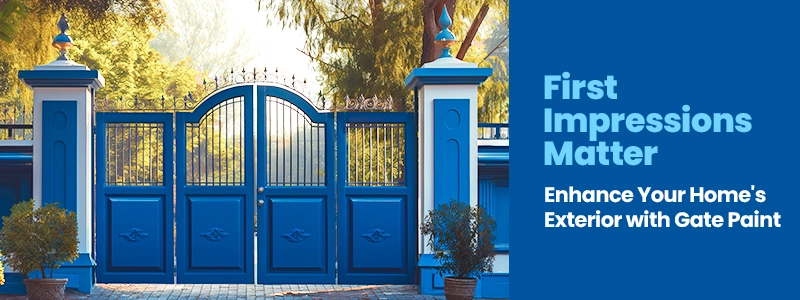Your home’s gate is more than just a security feature; it is often the first point of visual contact anyone has with your property. A well-maintained gate painted with care can convey a sense of welcome and pride. Conversely, a gate that’s flaking, rusty, or dull can give an impression of neglect, detracting from even the most beautiful garden or exterior. Here, we delve into why painting your gate is an essential home improvement task and how to achieve the best results.

The Importance of a Well-Painted Gate
A gate functions as both a practical and symbolic threshold to your home. It’s not just about aesthetics; a well-painted gate can also protect against wear from environmental factors like rain, wind, and UV exposure. Paint acts as a shield, preventing rust on metal gates and rot on wooden ones. In real estate, curb appeal matters, and the gate often plays a pivotal role in setting the expectations for the rest of the home.
Overcoming Common Gate Painting Challenges
Painting a gate might seem straightforward, but several issues can complicate the process:
Choosing the Correct Paint: Gates can be made from various materials, including wood, iron, and steel, and each requires a specific type of paint. For instance, metal gates often need a rust-inhibiting primer and a paint that can flex with temperature changes to prevent cracking.
Dealing with Weather: Paint needs time to cure, and weather conditions can greatly influence this process. High humidity can slow drying time and lead to a tacky finish, while wind can blow dust and debris onto wet paint, ruining the smooth finish.
Surface Prep Work: The longevity of a paint job significantly depends on the prep work. This might include stripping old paint, sanding down rough spots, filling holes, and ensuring the gate is impeccably clean and free of rust or mildew before beginning.
Maintenance After Painting: Regular maintenance is required to keep the gate looking its best. This could mean periodic cleaning, touch-ups to the paint job, and inspections for physical damage.
Guide to Painting Your Gate
To get a high-quality finish and ensure the paint lasts, follow these detailed steps:
Cleaning and Prepping the Gate: Start by removing old paint with a scraper or a wire brush. For rust and corrosion on metal gates, use a rust converter or a sandblaster for severe cases. Wash the gate with a degreasing cleaner or soapy water to remove oils, dirt, and residues. Let it dry completely.
Priming the Surface: Use a primer designed for the gate’s material. For metal, a rust-inhibiting primer is crucial. Wood gates benefit from an oil-based primer that seals the wood and helps prevent moisture penetration. Allow the primer to dry thoroughly as per the manufacturer’s instructions.
Paint Application: Select a paint that is appropriate for the material and exposed to outdoor conditions. Enamel paint is often recommended for metal gates because of its durability and resistance to elements. Apply the first coat thinly to avoid drips and uneven texture. Wait for the first layer to dry completely before applying a second coat. This may take longer than indoor paints due to varying outdoor conditions.
Final Checks and Touch-Ups: After the final coat, inspect the gate for any inconsistencies or missed spots. Apply a touch-up if necessary. Be sure to check the gate’s hardware as well; sometimes, removing old paint from hinges and bolts is necessary for smooth operation.
Conclusion
Painting your gate might seem like a small task, but it has a big impact on how your home looks and feels. A well-painted gate not only makes your home look nicer but also shows that you care about keeping things looking good.
Even though painting your gate can be tricky because of things like bad weather and picking the right paint, it’s worth it. Taking the time to clean your gate, put on a good primer, and paint it carefully will give you a gate that looks great and lasts a long time.
When it comes to picking the paint, go for quality. Nippon Paint Satin Enamel is a great choice because it’s tough, easy to use, and comes in lots of colours. Plus, it dries quickly, so you won’t have to wait long to see the results.
So, whether you’re getting your home ready to sell or just want it to look nice for you and your family, don’t forget about your gate. A fresh coat of paint can make a big difference and leave a lasting impression on everyone who sees it.
FAQ
What type of paint should I use for my home exterior gate?
It depends on the material of exterior gate. For metal gates, consider using a rust-inhibiting primer followed by a durable enamel paint. For wooden gates, opt for an exterior-grade paint or stain.
How long does gate paint typically last?
The longevity of gate paint depends on factors such as weather conditions, maintenance, and the quality of the paint used. Generally, a well-applied paint job can last several years before requiring touch-ups or recoating.
Can I paint my gate myself, or should I hire a professional?
Painting a gate is a manageable DIY project for many homeowners. However, if you’re unsure or have a complex gate design, it may be worth hiring a professional painter to ensure a high-quality finish.
How do I prepare my gate for painting?
Proper surface preparation is essential for a successful paint job. This may include cleaning the gate, removing old paint or rust, sanding down rough spots, and applying a primer suitable for your gate’s material.
What are some common mistakes to avoid when painting a gate?
Avoid painting in extreme weather conditions, such as high humidity or direct sunlight, as this can affect the paint’s drying and adhesion. Additionally, ensure thorough surface preparation and use the appropriate tools for even coverage.
